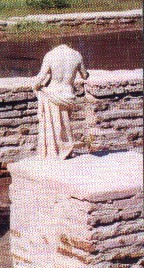|
ANCIENT
DION
Dion
is an area at the foot of Mt Olympus. Nowadays it is known all over the
world because archaeologists discovered a very important Macedonian city.
Ancient kings of Macedonia had chosen Dion as their summer resort. There
they created, centuries ago, a settlement in the ruins of which the parts
of the ancient Macedonian civilization are evident. Archaeologists, with
Professor D Pantermalis at the head of them, discovered an admirable
civilization. Remains of an ancient theatre, market baths and palace. The
findings of graves found in Dion area are also remarkable. Most royal
tombs give away the existence of an eminent and thriving civilization.
Today we can admire the ruins of that civilization in the archaeological
site of Dion and the archaeological museum of Dion.
HISTORICAL
FACTS
As Isiodos was singing, around 700 BC, about Zeus divine love for Thia,
the daughter of Greeks forefather Defkaliona, he said that she got
pregnant and had two children, Magnita and Macedona, who lived in Pieria
around Mt Olympus. Zeus’s sacred place in that area was Dion, at the
foot of Mt Olympus. The city of Dion is first mentioned in history, in the
description of general Brasida’s march from Thessaly to the country of
his fried, king of Macedonia, Perdika the second. It was the first city
Bracida’s encountered after crossing the borders, the summer of 424 BC
Towards the end of the 5th century according to the same
writer, Archelaos, who reorganized the state, strengthened central
authority, built up streets and fortresses and modernized the army, became
the king of Macedonia.
EXCAVATIONS
The
excavations that started in 1928 and were continued intensively by
professor Dimitrios Pantermalis, during the period of 1973-1988 proved
that Dion used to be during the ancient times, the sacred city of
Macedonians. Among the findings discovered, there are also Dimitra’s,
Icis’s temples, Dionisus’s villa and the Asklipio, streets and stores,
the semetary and the city wall, the Hellenistic and Roman theatre, Roman
baths with lot of sculptures. Many of the findings are exhibited today in
the archeological museum, foynd in the village at Dion.
MUSEUM
TIMETABLE (winter time)
MONDAY
10:30 – 17:00 |

